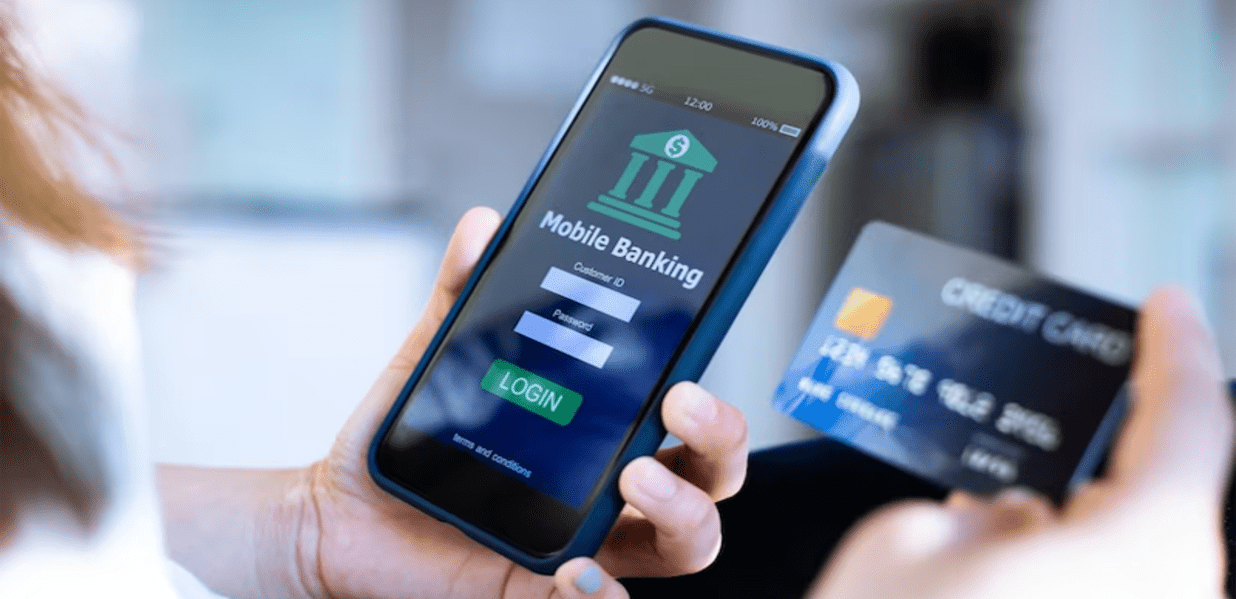


The way we manage our finances has been completely transformed by mobile banking applications in the fast-paced world of today. We can now check our accounts, transfer money, pay bills, and even apply for loans from the comfort of our homes with just a few touches on our smartphones.
But it's not simple to make a banking app that works well and satisfies the requirements of both the financial organization and its users. It necessitates a thorough comprehension of the fundamentals of developing mobile banking applications. To guarantee a seamless and secure banking experience, every factor—from strong security measures to user-friendly interfaces—must be carefully taken into account.
In this post, we'll examine the essential elements and capabilities that give banking apps their functionality, user-friendliness, and adaptability. So buckle up and let's study the fundamentals if you're prepared to start the path of developing a cutting-edge mobile banking app.
Mobile application banking, commonly referred to as mobile banking, is the process of accessing banking services and carrying out financial transactions via a mobile device, such as a smartphone or tablet. Users of mobile banking applications can easily manage their finances while on the go without having to go to a physical bank branch.
Recent years have seen a huge increase in the popularity of mobile banking due to its accessibility and convenience. Through mobile banking apps, users may carry out a variety of financial tasks, such as transferring money, paying bills, depositing checks, asking for loans, and even monitoring investments.
Compared to conventional banking techniques, mobile application banking has a number of benefits. It removes the need for paper documents, shortens wait times, and gives users access to their accounts round-the-clock. Additionally, real-time updates and warnings are frequently provided by mobile banking apps, assisting users in staying updated on their financial operations.
Strong security measures are put in place to protect the security of mobile banking. These comprise safe login utilizing biometrics or two-factor authentication, data encryption during transmission, and routine security audits to find and fix problems.
Overall, the way people manage their funds has been transformed by mobile application banking. It has improved user-friendliness, convenience, and accessibility of banking, enabling consumers to take charge of their financial lives.
A methodical approach and a solid foundation are necessary when building a financial app. Defining your goals and objectives is the first stage. What do you hope your software will accomplish? Is it to offer sophisticated features like investment management or to give basic banking services? You can go to the following steps as soon as you have clear eyesight.
Researching the market thoroughly is the second stage. Examine current banking apps to identify their advantages and disadvantages. Find creative solutions to the problems consumers frequently have by identifying their pain areas. This will enable you to set your software out from the competitors and offer a special selling point.
Create a strong app architecture after completing market research. This entails creating the user interface, outlining the app's flow, and wireframing the app's screens. A fluid user experience is guaranteed by a well-designed architecture, which also makes navigating the app simple.
The backend development is what you should concentrate on next. For seamless data transfer, this entails creating APIs, setting up secure servers, and interfacing with pertinent banking systems. Banking apps must prioritize security, therefore utilize multi-factor authentication and strong encryption mechanisms to safeguard user information.
After the backend is established, front-end development may begin. Coding the app screens, including interactive components, and making sure the design is aesthetically pleasing are all required. The user interface needs to be simple to use, with easy access to important functions and straightforward navigation.
Finally, extensive testing is crucial before releasing your software. Before releasing the software to the public, carry out thorough testing to find any flaws or glitches and solve them. During this stage, user feedback is also essential since it enables you to improve the app based on actual usage circumstances.
A diverse team of engineers, designers, and testers is needed to complete the challenging task of creating a banking app. To guarantee a successful app launch, a clear vision and a well-defined timetable are essential. You may develop a banking app that provides an easy-to-use and secure user experience by following these instructions and paying close attention to detail.
The price of creating a banking app might differ significantly depending on a number of variables. These factors include the complexity of the software, its feature set, the platforms it will run on, and the fees charged by the development team. A banking app's development can run anywhere from $50,000 to $300,000 or more on average.
The complexity of the app is one of the main cost factors. It will require more time and work to develop if you want to integrate more features and functionalities. Compared to apps with advanced capabilities like investment management and loan applications, basic banking apps with conventional functionality like account balance checks and fund transfers would be less expensive.
The price will also depend on the platform(s) you decide to build the app for. Creating banking software for just one platform, like iOS or Android, will be less expensive than doing it for several. However, keep in mind that focusing on several platforms might boost the app's reach and expand your user base.
Another important element is the rates of the development team. Rates vary based on the team's experience and location. Compared to teams situated in wealthy nations, offshore development teams could offer lower prices. However, it's crucial to strike a balance between price and quality and pick a team with expertise in creating safe and straightforward banking apps.
It's important to keep in mind that development costs are only the beginning. Additional expenses will be incurred for ongoing upkeep, updates, and security improvements. Therefore, it's crucial to account for these expenses when setting a budget for a banking app.
It's vital to think of the expense of creating a banking app as an investment, despite the fact that it may appear intimidating. A user-friendly and well-designed banking app may increase operational effectiveness, boost customer satisfaction, and draw in and keep clients.
Also Read: Benefits of Partnering With Banking App Development Company
A successful banking app needs to meet the evolving needs of both the financial institution and its customers. Here are some key components and features that a banking app should have:
The app should have a clean and intuitive interface that allows users to navigate easily and perform transactions effortlessly. Clear and concise labels, icons, and menus contribute to a positive user experience.
Security is paramount in banking apps. Implementing strong authentication mechanisms such as biometric authentication (fingerprint or face recognition) and two-factor authentication adds an extra layer of security to protect user accounts.
Users should be able to view their account balances, transaction history, and account details. They should also be able to perform actions such as transferring funds between accounts, paying bills, and setting up recurring payments.
Enabling users to transfer funds between their own accounts, as well as to other accounts within the same financial institution or to external accounts, is a crucial feature of a banking app.
This feature allows users to deposit checks by simply taking a photo of the check using their smartphone's camera. The app then processes the image and credits the deposited amount to the user's account.
Users should receive real-time alerts and notifications for activities such as low balance, large transactions, and account login from an unknown device. This helps users stay informed and enables them to take immediate action if necessary.
A banking app should provide easy access to customer support channels, such as live chat, email, or phone support. Prompt and efficient customer support is essential for resolving any issues or concerns that users may have.
Including features that help users track their spending, set budgets, and analyze their financial habits can greatly enhance the value of a banking app. This empowers users to make informed financial decisions and manage their finances more effectively.
These are just a few essential components and features that a banking app should have. It's important to continuously gather feedback from users and adapt the app to meet their changing needs and expectations.
There are three main types of mobile banking:
This is the most basic form of mobile banking. Users can send simple text messages to their financial institution to check their account balances, view recent transactions, and receive alerts. SMS banking does not require a smartphone or internet access, making it accessible to a wide range of users.
Mobile web banking involves accessing a financial institution's website through a mobile browser. Users can log in to their accounts and perform various banking activities, similar to online banking on a computer. Mobile web banking requires an internet connection but does not require the installation of a dedicated app.
Mobile app banking is the most popular and advanced form of mobile banking. Users download and install a dedicated banking app on their smartphones or tablets. These apps provide a range of features, such as account management, fund transfers, bill payments, and more. Mobile app banking offers a seamless and user-friendly experience, with enhanced security features and offline access to certain banking functions.
In conclusion, careful consideration of a number of variables is necessary for the development of a good banking app. To deliver a seamless and secure banking experience, every element—from user-friendly interfaces to strong security measures—must be carefully crafted. You may construct a banking app that satisfies the requirements of the financial institution and its clients by using a methodical strategy, conducting in-depth market research, and working with a talented development team.
Do you want to create a cutting-edge banking application that increases productivity and offers a flawless user experience? Look nowhere else! We cordially invite you to cooperate with our premier banking app development firm right away.
Start the transformation of your financial services today and embrace the digital revolution. For a customized proposal and to discuss your project needs, get in touch with us right now. Let's work together to create a superb, user-focused app that will influence banking in the future!

Hello there! I'm Jayesh Chaubey, a passionate and dedicated content writer at Infiniticube Services, with a flair for crafting compelling stories and engaging articles. Writing has always been my greatest passion, and I consider myself fortunate to be able to turn my passion into a rewarding career.
Our newsletter is finely tuned to your interests, offering insights into AI-powered solutions, blockchain advancements, and more.
Subscribe now to stay informed and at the forefront of industry developments.